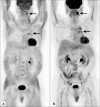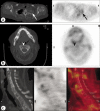Use of PET/CT scanning in cancer patients: technical and practical considerations
- PMID: 16252023
- PMCID: PMC1255942
- DOI: 10.1080/08998280.2005.11928089
Use of PET/CT scanning in cancer patients: technical and practical considerations
Abstract
This overview of the oncologic applications of positron emission tomography (PET) focuses on the technical aspects and clinical applications of a newer technique: the combination of a PET scanner and a computed tomography (CT) scanner in a single (PET/CT) device. Examples illustrate how PET/CT contributes to patient care and improves upon the previous state-of-the-art method of comparing a PET scan with a separate CT scan. Finally, the author presents some of the results from studies of PET/CT imaging that are beginning to appear in the literature.
Figures












Similar articles
-
More advantages in detecting bone and soft tissue metastases from prostate cancer using 18F-PSMA PET/CT.Hell J Nucl Med. 2019 Jan-Apr;22(1):6-9. doi: 10.1967/s002449910952. Epub 2019 Mar 7. Hell J Nucl Med. 2019. PMID: 30843003
-
Positron emission tomography/computed tomography--imaging protocols, artifacts, and pitfalls.Mol Imaging Biol. 2004 Jul-Aug;6(4):188-99. doi: 10.1016/j.mibio.2004.04.006. Mol Imaging Biol. 2004. PMID: 15262234 Review.
-
Clinical practice guidelines for the utilization of positron emission tomography/computed tomography imaging in selected oncologic applications: suggestions from a provider group.Mol Imaging Biol. 2007 Nov-Dec;9(6):324-32; discussion 323. doi: 10.1007/s11307-007-0106-3. Mol Imaging Biol. 2007. PMID: 17701257
-
Comprehensive Oncologic Imaging in Infants and Preschool Children With Substantially Reduced Radiation Exposure Using Combined Simultaneous ¹⁸F-Fluorodeoxyglucose Positron Emission Tomography/Magnetic Resonance Imaging: A Direct Comparison to ¹⁸F-Fluorodeoxyglucose Positron Emission Tomography/Computed Tomography.Invest Radiol. 2016 Jan;51(1):7-14. doi: 10.1097/RLI.0000000000000200. Invest Radiol. 2016. PMID: 26309185
-
Positron emission tomography/computed tomography.Semin Nucl Med. 2008 May;38(3):152-66. doi: 10.1053/j.semnuclmed.2008.01.003. Semin Nucl Med. 2008. PMID: 18396176 Review.
Cited by
-
Investigation of tumor assessment between two PET systems using various indices: comparison between PET/CT and PET/MRI systems.Am J Nucl Med Mol Imaging. 2023 Aug 15;13(4):156-163. eCollection 2023. Am J Nucl Med Mol Imaging. 2023. PMID: 37736495 Free PMC article.
-
Cancer and positron emission tomography imaging in India: Vision 2025.Indian J Nucl Med. 2016 Oct-Dec;31(4):251-254. doi: 10.4103/0972-3919.190804. Indian J Nucl Med. 2016. PMID: 27833308 Free PMC article. No abstract available.
-
False-Negative 18F-Fluorodeoxyglucose PET/CT in Malignant Pleural Mesothelioma.Cureus. 2021 Aug 17;13(8):e17263. doi: 10.7759/cureus.17263. eCollection 2021 Aug. Cureus. 2021. PMID: 34540486 Free PMC article.
-
Understanding Biologically Guided Radiotherapy: Essential Insights for Surgical Oncologists.Indian J Surg Oncol. 2024 Dec;15(Suppl 4):599-605. doi: 10.1007/s13193-024-02070-1. Epub 2024 Aug 21. Indian J Surg Oncol. 2024. PMID: 39995527 Review.
-
Stem Cells as a Novel Source for Regenerative Medicinal Applications in Alzheimer's Disease: An Update.Curr Mol Med. 2025;25(2):146-166. doi: 10.2174/0115665240334785240913071442. Curr Mol Med. 2025. PMID: 39318206 Review.
References
-
- Warburg O. In: The Metabolism of Tumors. Dickens F, editor. London: Constable; 1930. pp. 129–169.
-
- Beyer T, Townsend DW, Brun T, Kinahan PE, Charron M, Roddy R, Jerin J, Young J, Byars L, Nutt R. A combined PET/CT scanner for clinical oncology. J Nucl Med. 2000;41:1369–1379. - PubMed
-
- Lardinois D, Weder W, Hany TF, Kamel EM, Korom S, Seifert B, von Schulthess GK, Steinert HC. Staging of non–small-cell lung cancer with integrated positron-emission tomography and computed tomography. N Engl J Med. 2003;348:2500–2507. - PubMed
-
- Antoch G, Saoudi N, Kuehl H, Dahmen G, Mueller SP, Beyer T, Bockisch A, Debatin JF, Freudenberg LS. Accuracy of whole-body dual-modality fluorine-18–2-fluoro-2-deoxy-d-glucose positron emission tomography and computed tomography (FDG-PET/CT) for tumor staging in solid tumors: comparison with CT and PET. J Clin Oncol. 2004;22:4357–4368. - PubMed
LinkOut - more resources
Full Text Sources
Other Literature Sources
